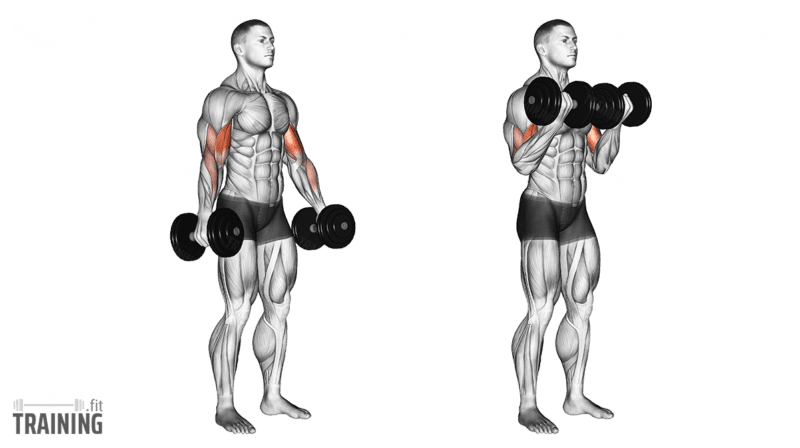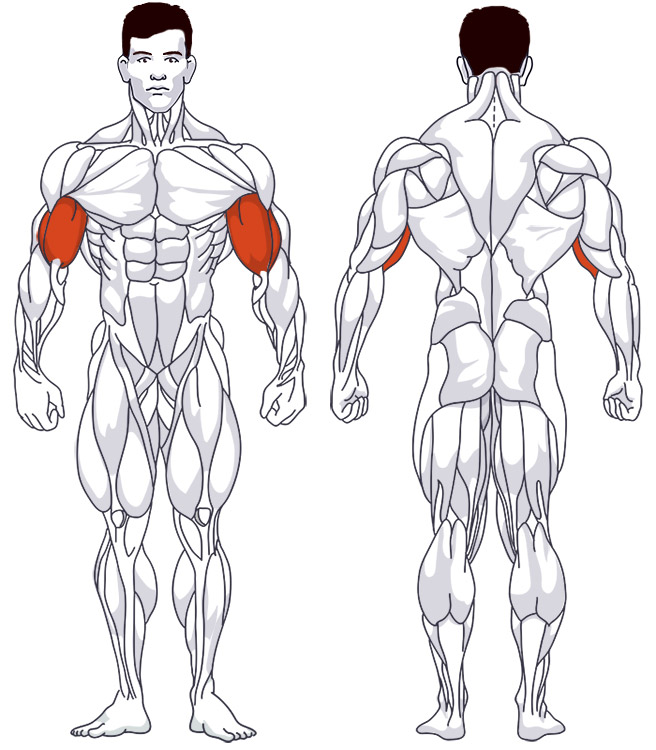Biceps Curls
Isolation exercise, Free weightsOverview

Main muscles
- Biceps: Arm flexor
(Musculus biceps brachii)
Training plans
Here you can find example plans for biceps curls training:
Biceps Curls: Basics and alternatives

Involved main muscle groups:
Biceps Curls
Biceps curls are definitely one of the most well-known exercises out there. You hold a weight in your hands and move it by extending and curling your arms at the elbows. Biceps curls are popular not just in the gym, but you’ll also often see them in movies and on TV.
What beginners might not realize is that biceps curls come in many different variations. Sitting, lying or standing, using a cable pulley or a machine, with dumbbells, a barbell, or EZ bars, and more. Depending on the equipment, grip position, and execution, you can target the biceps differently.
In any case, you’ll be training the long head (Musculus biceps brachii, Caput longum) and the short head (Musculus biceps brachii, Caput breve) of the biceps muscle. The upper arm muscle (brachialis muscle) is also involved.
The movement sequence of biceps curls is simple, making it a great exercise for beginners.
Basic exercises instead of biceps curls
Biceps curls are so popular because they provide a fantastic muscle feel due to the high isolation of the biceps. And, of course, everyone wants to have big arms. Although the exercise is easy to learn and master, for beginners, biceps curls might not always be the best choice to start with.
The biceps are also activated during basic exercises like pull-ups and rows, which can stimulate muscle growth while training larger muscle groups simultaneously.
Correct execution
As mentioned earlier, there are many ways to perform biceps curls, and no one-size-fits-all recommendation.
However, the classic biceps curls using two dumbbells are a simple and effective option due to the isolation of the target muscles. All you need for this are two dumbbells.
Video tutorial
Step-by-step instructions
Hold a dumbbell in each hand with your arms extended alongside your body.
Raise the dumbbells simultaneously by bending your elbows. As you start the movement, turn your palms forward so that they face forward at the beginning of the sequence.
Once at the top, hold the tension briefly. The backs of your hands should now face forward.
To complete a biceps curl repetition, lower the dumbbells back down in a controlled manner. Your palms will follow the same sequence in reverse order.
Alternative versions
Biceps curls are easy to learn and perform. Besides the variation described above, there are other ways to do the curls. See below.
Alternating biceps curls
The step-by-step instructions describe the execution with both dumbbells being lifted simultaneously. You can also perform biceps curls alternatively.
That means you don’t lift the second arm until you’ve completed the first arm’s movement. This reduces the workout’s intensity a bit, and the longer rest may allow you to do more reps.
Biceps curls with a small range of motion
Typically, you perform biceps curls through the entire range of motion, moving the dumbbell from the starting position near your hip to the highest point where there’s still tension.
Sometimes, though, you’ll see people at the gym shortening their movement. This method is also legitimate. However, it sets a reduced training stimulus, and primarily you gain strength in that range of motion. Overall, the strength increase is weaker with a reduced range of motion.
This variant is recommended only if you want to eliminate specific weaknesses in one area of the range of motion. In the long run, performing the exercise fully is a better option.
Isometric hold
Another variation of the biceps curls involves holding the weight statically in the air. Instead of moving the dumbbells up and down, lift your arms just once and then hold them in the air for as long as possible.
After a short time, this places a high load on the muscles, stimulating growth. Just as with the biceps curls with a smaller range of motion (see above), you train the biceps differently depending on the position of your forearms. If the dumbbells are closer to your shoulders, you’ll set a different training stimulus than if you lower the dumbbells closer to the floor.
This type of execution is more suitable for advanced users.
Common mistakes
Far too often, you’ll see biceps curls being performed with a swinging motion at the gym. The dumbbells aren’t lowered in a controlled manner, but rather swung down quickly until the arms are fully extended. When the arms are fully stretched, the momentum is used to bring the dumbbells back up. This execution should be avoided because it significantly reduces the training stimulus.
In general, make sure that the dumbbell movement is done primarily through the elbows. Biceps curls don’t start from the shoulders.